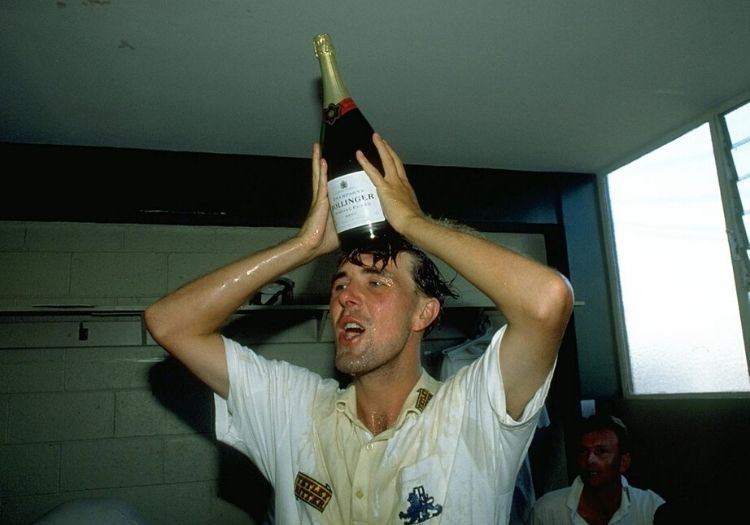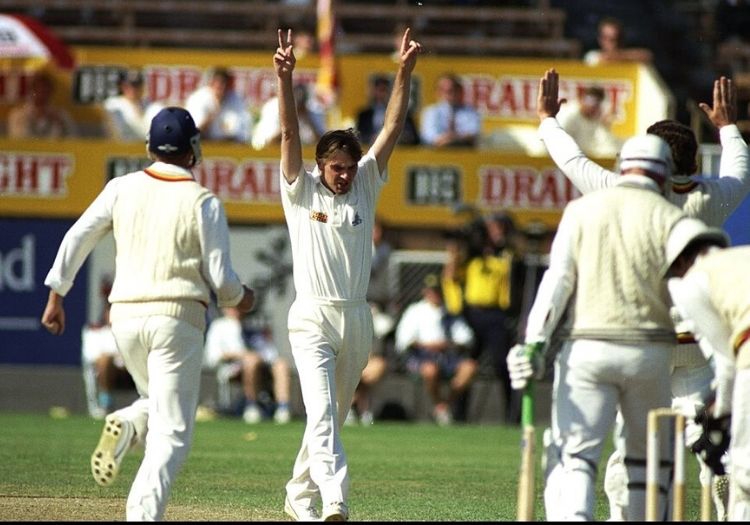ROB SMYTH recalls England’s triumphant trip to New Zealand in 1991/92, ‘the forgotten tour’ when Tufnell felt on top of the world


An extraordinary thing happened in this summer’s World Cup final: England won a match against New Zealand that nobody will ever forget. Usually, only the defeats are remembered – landmarks in the latest existential crisis, each given their own evocative shorthand. The ‘sex, drugs and rock ‘n’ roll’ tour of 1983/84; Ilford 2nd XI in 1986; the worst team in the world in 1999.
It surely says plenty about the psyche of English cricket and the attitude towards New Zealand; a contradictory mixture of entitlement, superiority, self-loathing and fatalism. In the 1990s, England won four out of five Test series against New Zealand. But the only one anyone really talks about is that defeat in 1999. That’s especially harsh on the teams that won so impressively, 2-0 each time, in New Zealand in 1991/92 and 1996/97.
When England arrived in January 1992, New Zealand had not lost a series at home for 13 years. Sir Richard Hadlee had recently retired, but they would be good enough to draw 1-1 against an increasingly formidable Australia a year later. Yet England, enjoying a rare period of serenity in a tumultuous decade, beat them with ease.
Nor was it just a workmanlike procession. The first Test victory was so dramatic and unlikely that it wouldn’t have looked out of place in the summer of 2019. Yet the thing most people remember from the tour is the thing we are all desperate to forget: the awful twist of fate that all but ended David ‘Syd’ Lawrence’s career.
Even at the time, most of the focus was on the World Cup which followed the Test series. England picked the same squad for the Test and one-day series in New Zealand, which meant Dermot Reeve played his only three Tests. Unlike in 2019, England managed to excel in both formats. They whitewashed New Zealand 3-0 in the ODIs, and went unbeaten on a full tour – warm-up matches included – for the first time in 24 years.
It was all pretty low-key. When England turned up 90 minutes before the start of the Test series, the gates were still locked and nobody was around. The match was a run-fest. Only 22 wickets fell in the first 14 sessions and, though New Zealand followed on, they were only three down in the second innings and easing towards a draw. England were also three down – in their case, to their last three fit specialist bowlers. As the final session began, the press box was the venue for a card game and the New Zealand wicketkeeper Ian Smith had packed his bags.
Then John Wright, stuck on 99 for 23 minutes either side of tea, lost his head while all around were keeping theirs; he charged Phil Tufnell and was stumped by a mile. Wright’s peculiar panic changed the mood and sparked an unfathomable collapse.
Eventually it came down to Martin Crowe, the New Zealand captain, against Tufnell. With 10 minutes’ play remaining, New Zealand were four runs behind and had one wicket remaining.
Alec Stewart made sure Crowe heard him tell everyone that a boundary would save the game, because England would not have time to bat again due to the change of innings. Crowe gambled and lost, mistiming a lofted drive off Tufnell that was nonchalantly taken at mid-off by Derek Pringle.
For the third consecutive Test, Tufnell had been England’s matchwinner. “Seven for 47 – is that what it was?” he said cheerily after the game. “I suppose it was a good spell then.”
His match figures of 11 for 147 were the first Test 10-for by any spinner for three years. He was 25 years old and many regarded him as the world’s best spinner. The leg-spin revival was a thing of the near future; Mushtaq Ahmed, Shane Warne and Anil Kumble had played three, two and one Test respectively. Tufnell’s classical flight and craft – he dismissed Crowe with what he called his ‘ball on a string’ – added to his charm, and it felt like England had found a spinner who could be locked in for the next decade. Apart from a famous performance against Australia at The Oval in 1997, it would never be as good again. “At this point in my embryonic Test career,” he said later, “I felt as though I could bowl out any batsman alive.”

Tufnell took the crucial wickets of John Wright and Martin Crowe
If Tufnell was the star of the series, Stewart wasn’t far behind. He took a shortcut from emergency wicketkeeper to established opener and vice-captain, scoring two hundreds and playing with an authority and patience of which many felt him incapable. The tour was one long epiphany for Stewart. He was suspicious when he was asked to open – he preferred No.3 – but enjoyed the experience so much that he wanted to do so for the rest of his career. He would not always get his wish.
His partner, Graham Gooch, had a poor series. But he also made an extraordinary second-innings hundred on a dicey wicket in the second Test at Auckland, when he seemed to play and miss at least once an over. With the ball seaming violently, Gooch went into what he called his “dangerous wicket mode”, playing the line of the ball as late as possible, so that any seam movement would almost certainly take it past the edge. This, truly, was an example of a batsman making his own luck.
Allan Lamb had an alternative mode on such pitches – smack as many as you can before you get one with your name on it. His riotous 47-ball 60, in partnership with Gooch, helped England win by 168 runs – a huge margin in such a low-scoring game. It was quite a comeback: on the first morning, having been put in on a moist, green pitch, they were 9 for 3 and then 91 for 6. It was England’s fourth consecutive Test win, the only time they achieved the feat between 1979 and 2004. And New Zealand, who had lost two home Tests in 13 years, had now lost two more in 17 days.
The third Test, a dead rubber, soon developed a testimonial feel. Ian Botham, who had joined the tour late so he could play the King in the pantomime Jack and the Beanstalk, made his 100th Test appearance when Pringle suffered a back problem. New Zealand dominated a slow-scoring match – Tufnell and Graeme Hick shared 140 overs in the first innings – which was meandering towards a draw in the final session of the final day. This time, there really was no chance of a result.
That didn’t register with Lawrence, a puppy-keen fast bowler who gave everything to every delivery. When he bowled the first ball of his third over, his kneecap cracked and he collapsed on the turf. The sounds – the gunshot crack and then the instant scream of pain – are so haunting that the YouTube clip should come with a warning. Botham recalled seeing both parts of the kneecap through the skin, three or four inches apart. Pretty much all of the England players say it was the worst thing they ever saw on a cricket field.
“I knew instantly it was incredibly serious, because you just don’t see a bloke who’s 6ft 3in and 18 stone cry with pain like that,” said Robin Smith. “I can still picture him banging his fist on the pitch with such force that you could see the ground move. Syd was such a nice bloke, the definition of a gentle giant. It was so sad.”

Tufnell was named man of the match in the first Test at Christchurch
Lawrence’s injury effectively ended his career, though he made a brief, heroic comeback for Gloucestershire five years later. There were a number of sliding doors that led to his injury. He was bowling only because England declared; he was playing only because Chris Lewis was born with Raynaud’s Phenomenon, which affects the circulation and meant it took his middle finger – which was split by the abrasion of the seam – took longer than usual to heal.
Reeve also wondered whether the pre-tour training on a rock-hard pitch at Lilleshall was a factor. A number of bowlers complained of soreness, including Lawrence with the left knee that would later fracture. The shock pads on the bowler’s landing had been taken out because they affected the bias when indoor bowls was played.
England went straight into the World Cup, where they were the best team in the group stages along with New Zealand before running out of steam. Botham has always said they paid the price for working too hard in New Zealand, though Gooch disagreed.
“I was very proud to have been associated with all the England players on the three-month tour and the contrast with our trip a year earlier [when England were thrashed 3-0 in the Ashes and Gooch said the series was like “a fart competing with thunder”] couldn’t have been greater,” he said. “The boys showed what I had been looking for under my captaincy – a pride in performance for our country and a professional attitude to the job in hand.”
To Gooch, Tufnell symbolised the difference between the two tours. To Tufnell, professionalism was an illusion glimpsed in the aftermath of victory. “My behaviour was no different to what it had been in Australia the year before, involving the same number of liaisons, the same number of units of alcohol and the same number of scrapes,” he said. “When you are winning, all the larks and pranks are considered funny.”
One thing every England player would agree on was that, Lawrence’s injury excepted, it was one of the happiest tours of their career. Not even the great West Indies side of the 1980s won a series in New Zealand, so this really is something to shout about – whether people remember it or not.
This article was published in the November 2019 edition of The Cricketer - the home of the best cricket analysis and commentary, covering the international, county, women's and amateur game
To remind ourselves of happier times we’re offering a £20.19 subscription to celebrate England’s World Cup win once again. Click here to claim
Subscribe to The Cricketer for exclusive content every day: The inside track on England's Test tour with George Dobell in Pakistan, award-winning analysis, breaking news and interviews and the only place for in-depth county coverage all year round. Plus: An ad-free app experience at your fingertips. Subscribe to thecricketer.com today for just £1.